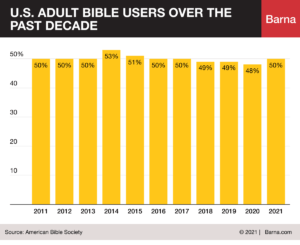Fewer Americans may be joining churches, but about the same number as before are reading the Bible, a new survey finds.
The bar for determining who reads the Bible is fairly low by most Sunday school standards — pollsters define “Bible users” as individuals who read, listen to or pray with the Bible on their own at least three or four times a year outside of a church service or church event.
The annual research is conducted by the American Bible Society in collaboration with Barna Research. The survey began in 2011, and the findings have remained fairly steady over the last decade.
However, the pandemic year found more Americans reaching for a Bible at least occasionally. This year’s research found a two-point bump (from 48% to 50%) in the share of Americans who are Bible users comparing January 2021 to January 2020. That month right before the pandemic hit in 2020 was the lowest point of recorded Bible usage for the decade.
Yet from a statistical perspective, the fluctuation between 48% as a low and 53% as a high is considered fairly steady.
This steady pattern of Bible use contrasts with other annual polling that has shown the number of Americans who are members of religious congregations continues to decline, as does church attendance.
Despite this uptick, most Americans aren’t ready to compete in a Bible drill.
Despite this uptick, most Americans aren’t ready to compete in a Bible drill. Fully half of all Americans read the Bible never or less than twice a year.
That corresponds with other research showing biblical illiteracy continues to grow in the United States. Even though more than 90% of Americans say they own a Bible, and even though the average American household has three, fewer than half of Americans can name the first book of the Bible.
America’s rising biblical illiteracy caused the pollster George Gallup to comment: “We revere the Bible, but we don’t read it.”
 On the other hand, one in six American adults reads the Bible most days of the year, the new Bible Society/Barna data found. The pollsters estimate that 128 million American adults read the Bible with regularity. Only 16% of adults say they read the Bible nearly daily — but that’s up four points from the 12% who did so in January 2020.
On the other hand, one in six American adults reads the Bible most days of the year, the new Bible Society/Barna data found. The pollsters estimate that 128 million American adults read the Bible with regularity. Only 16% of adults say they read the Bible nearly daily — but that’s up four points from the 12% who did so in January 2020.
And this year’s survey found one big shift — among those who previously were classified as “Bible disengaged” to a more open category called the “movable middle.”
In January 2018, more than half the population (54%) was considered disengaged. This year, however, the number of Bible disengaged dropped to 39%. This movable middle group has grown from 26% of the population to 37%. So while the number of Americans who read the Bible regularly has held steady (and small), the number who appear to be open to reading the Bible more often has grown.
While the number of Americans who read the Bible regularly has held steady (and small), the number who appear to be open to reading the Bible more often has grown.
When it comes to what Americans believe about the Bible — whether they read it or not — 71% believe it is the word of God, whether literally or figuratively. Just more than half (51%) believe the Bible is without error, although only 26% believe every word of the Bible should be understood literally. A full third of Americans believe the Bible is the word of God that should be interpreted both literally and symbolically.
Only 13% believe the Bible is “just another book that contains stories and advice,” the pollsters reported. And only 10% of Americans believe the Bible was written to control or manipulate people.
Related articles:
Are you sure the Bible actually says that? | Opinion by Russ Dean
The word of God may not be what you think it is | Opinion by Chuck Queen
Atheists outpace evangelicals in knowledge of faith
Less than half of Americans now claim a formal congregational membership


